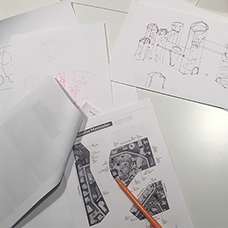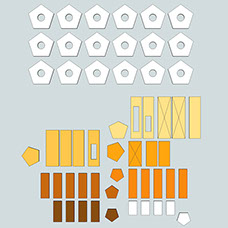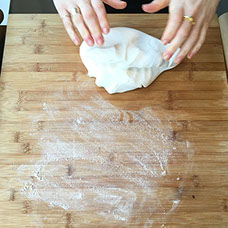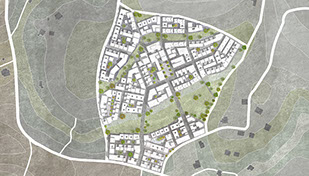
Insight
Gingerbread City
Gingerbread City
An exhibition at the V&A museum
Foreword
Six steps to designing, baking and building an ideal city of the future, for 2018’s Gingerbread City at the V&A. We worked alongside Foster & Partners, Zaha Hadid Architects and in collaboration with Stirling Prize-winner Haworth Tompkins and Pitman Tozer
Working alongside Foster & Partners and Zaha Hadid Architects, LGA has helped imagine, design and build an ideal city of the future – out of gingerbread. Hosted by the V&A, the 2018 edition of the Gingerbread City envisions an ideal ‘future city’. This includes urban farmland, a liquorice cable car and sugar cycle paths, and was in part built by robot.
LGA secured one of 71 plots, masterplanned to include the city farm’s entrance pavilion and learning centre, collaborating with neighbours Stirling Prize-winner Haworth Tompkins and Pitman Tozer. The three practices are also working together at the innovative mixed-use scheme Fish Island Village, in east London.
We worked with Ottolenghi pastry chef Monika Kos to create a soft and spicy, yet structurally sound gingerbread recipe, available here. You can vote for your favourite structure here.

01
Find the plot
Located in the city’s ‘central slice’, 15cm above sea level, our plot includes two buildings: the landmark entrance pavilion to the city farm, and an education centre where citizens and visitors can learn about farming, food provenance and production.

05
Technical design
From a SketchUp model, we produced grey board templates to shape the 60 individual dough pieces.

02
Concept design
The landmark entrance pavilion is a pentagonal tower topped with a light-filled dome. The education centre is composed of stepped structures, signifying the progression of learning.
Public realm integrates with the city farm on the next-door plot, while the buildings’ pentagonal and stacking themes coordinate with Pitman Tozer’s Recoverbee Centre and Haworth Tompkins’ Biscuitwork Tower.

06
Construction and installation
After baking for 15 mins, the pieces were flattened with a hot tin and the edges painstakingly chamfered using a microplane. The pieces were glued together with strong icing and assembled on a board. Carefully transported to the V&A, it was fitted into the City like a jigsaw piece.
LED lights were fed into the structure from beneath, and landscaping completed with fondant swans and snowmen, Tic Tacs, laces, and – in a sustainability masterstroke – the gingerbread shavings were reused as pathways.


03
Building blocks
Working with Ottolenghi’s pastry chef Monika Kos, over several weeks we concocted and honed the ideal gingerbread recipe. The final product was robust enough to withstand handling and tooling and to stay up for the length of the exhibition and beyond.
04
Sweet success
Dropping boiled sweets into apertures cut in the gingerbread, part way through baking, resulted in stained-glass windows. Un-festive to the last, humbugs are no good – they boil over and are opaque. Best performer was the Fox’s glacier mint, with its lovely, translucent finish.
GINGERBREAD RECIPE
Ingredients
- 5 tbsp water
- 210 g white caster or light brown sugar
- 3 tbsp golden syrup light batch only
- 250g salted butter cold and diced
- 1 tsp bicarbonate of soda
- 560g plain flour, plus extra for dusting
Method
Begin by placing in a deep saucepan the water, brown sugar, treacle, golden syrup, ground ginger, cinnamon and cloves. Bring the mixture to the boil over a medium heat, stirring continuously.
Remove from the heat and gradually add the diced butter. Stir until combined. Add the bicarbonate of soda – take care as the mixture will swell up. Leave to cool to room temperature. Once cool, transfer the mixture to a large bowl. Sift in the flour and slowly mix together until combined into a uniform and slightly wet dough. Wrap in cling film, flatten it with the palm of your hand and refrigerate until firm. It will take 2/3 hours. Place the dough within two sheets of baking paper and roll it out with the rolling pin until about 5–6mm thick. Cut the biscuits as described in the “tips” section, place the biscuits onto the silicon mat and chill again in the fridge (or in the freezer) until firm, for approximately half an hour.
Before putting the biscuits into the oven, make a hole by pressing a straw onto their surface: don’t lift them, just press the straw onto the biscuit to create the hole. Pre-heat the oven to 200° C and bake the biscuits for 8–10 minutes, taking care to make them crunchy by cooking them another two minutes with the door of the oven slightly open. While they are still hot, give better definition to the hole by pressing again the straw in it
Related
SUBSCRIBE
Click below to subscribe to our newsletter or to manage your preferences
Subscribe to our newsletter
© 2020 Lyndon Goode Architects Ltd






